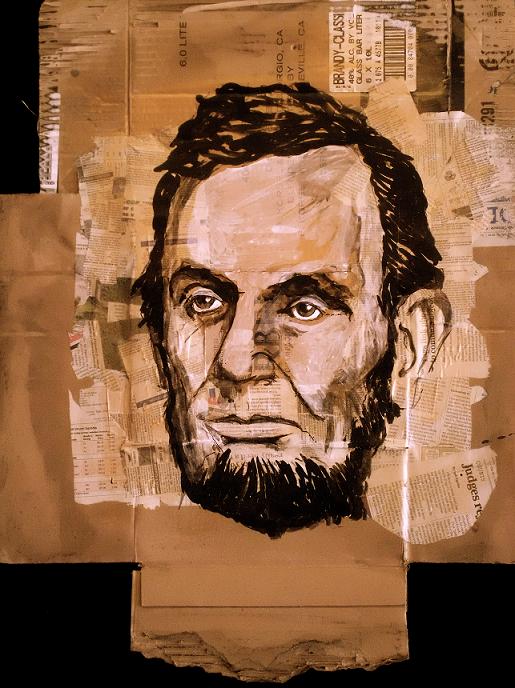The panic that grips you in those moments when you need to open a new checking account, but really needed a double shot of espresso are over. Yes, my moneyed mates, greetings and welcomes to the Financial District’s somewhat recently opened Capital One 360 Cafe.
Within the gleaming walls, one can perform banking transactions and caffiene transactions with well trained bank staff-baristas. You can plan ahead and reserve a workspace at which you will enjoy free WiFi thanks to corporate America’s largess. And for a limited time on those gleaming walls, you can enjoy artist Nick Mancilla‘s commentary on the transience of wealth while you bask in the endless future of your own, unfurling before you like a expensive, woven, cheerful, infinite Stars and Stripes.
Yes, Mancillas’ portraits of our nation’s money men — Lincoln and the rest of his dollar bill brothers — on recycled cardboard from his “Cardboard Currency” series will star in a Capital One 360 Cafe art show that opens on March 28. We got in touch with the Sonoma art teacher via email to chat about how weird the whole thing is.
The cafe bank art gallery art bank cafe. Photo by Yelp user Luis C.
SFBG How did this show come about? Did Capital One contact you or vice versa?
NM It was serendipitous, because a friend told me about an interesting new financial institution in downtown SF (which fit my theme) with a gallery space for artists. I’ve been Sonoma County art educator for over 19 years by day and working artist by night — who’s just completed my MFA – so I’m always looking for venues to show. I went and walked through the space and immediately loved the concept of the marriage of a show like mine about money being at a big bank. Contacted them, gave them my website, and a few months later they gave me the green light.
This is exactly my message — because I have a Capital One account, I’m involved with capitalism, I’m just like every other American … we have to believe in money to live. The pieces are meant to tell the story about the fact that although trying, we have to have faith that even though money is no longer really backed by gold and is re-printed by the government by the billions we still believe (to live our lives) that this money we have in our pockets and bank accounts will still continue to hold value. This act of faith which is so scary is part of what inspired my “Cardboard Currency” collection.
SFBG Have you spent time in the cafe?
NM Yes, before I approached them and I’ve been back several time since to both measure the space and sit for a cup of coffee to witness how folks interact with the space.
SFBG When you were making these pieces, did you have intentions for them to be shown in a bank?
NM The collection was created before the show was booked – it was inspired by the financial calamities of 2007, 2008, 2009, 2010, 2011 … and on. When I saw the space in a bank I thought, “wow that would be an thought-provoking message to have the ‘Cardboard Currency’ show at a banking institution.”
SFBG Do you think that their intended message will come across in that setting?
NM Not sure. People have a variety of responses to seeing them. What’s interesting is two pieces that already sold, both to financial industry professionals.
It’s a subtle yet powerful message. The paintings are on cardboard commercial packaging — [they talk about] the ethereal, transient nature of money.
Ultimately I think the work will be appreciated. If you look closely you can see the message in the materials and work. The cardboard on which each piece is created for example still shows the bar codes, packaging instructions, and transit information that delineates the origins of the piece of cardboard.
This is a message onto itself which I’m very fond of. That these boxes come from Thailand, Malaysia, Mexico, and all across the world in the flow of global commerce. These cardboard boxes in my small town from across the world brings to light how interconnected (our) money is with the world and world-wide economy and community. The vast expansiveness of our world and yet how small a world it is. More importantly, how connected we all are on this very basic level as humans, the human race, and as financial partners. When one family loses a home in California, it’s intrinsically connected to other financial tragedies across the globe and back again. I’ve also got plans for collections depicting presidents/figure heads on other nations currency’s in the near future.
“Cardboard Currency”
Through April 4
Capital One 360 Cafe
101 Post, SF

